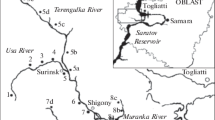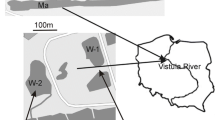Abstract—Features of the seasonal changes in the number of species, biomass, and the ratio of taxonomic groups of phytoplankton in flowing and regulated sections of the Ural River are described. In the unregulated section of the river, the maximum number of species was recorded in July and in the upper and lower reaches, in October. The maximum biomass of phytoplankton in the unregulated section of the river and in the lower part of the reservoir was recorded in summer, and in the upper part, in spring. The effect of a combination of a number of parameters of water bodies and environmental factors such as the typology, morphometry, flow velocity, input of substances from the catchment area and from the upper areas, and the temperature on the quantitative characteristics of communities is discussed. The leading role of the water temperature for phytoplankton development is shown in the unregulated sections of the river and in the lower part of the reservoir, which are characterized by environmental conditions that impede the abundant development of phytoplankton: high flow rates, the late onset of biological spring, and low nutrient availability. The biomass values correspond to β-mesotrophic–β-eutrophic waters in the unregulated sections of the river, to β-mesotrophic in the upper part of the reservoir, and to α-β-mesotrophic in the near-dam part. According to the saprobity index, the entire area surveyed is characterized by β-mesosaprobic conditions.
Similar content being viewed by others
Notes
see http://ueiv.ru/.
REFERENCES
Ahlgren, G., Lundstedt, L., Brett, M., and Forsberg, C., Lipid composition and food quality of some freshwater phytoplankton for cladoceran zooplankters, J. Plankton Res., 1990, vol. 12, no. 4, pp. 809–818.
Datsenko, Yu.S., Evtrofirovanie vodokhranilishch. Gidrologo-gidrokhimicheskie aspekty (Eutrophication of Reservoirs: Hydrological and Hydrochemical Aspects), Moscow: GEOS, 2007.
Datsenko, Yu.S., Puklakov, V.V., and Eidelshtein, K.K., The analysis of the abiotic factors influence on phytoplankton development in low-flow stratified reservoir, Tr. Karel. Nauchn. Tsentra Ross. Akad. Nauk, 2017, no. 10, pp. 73–85. https://doi.org/10.17076/lim611
Dogadina, T.V., Pyrophyte algae of wastewaters, Gidrobiol. Zh., 1974, vol. 10, no. 1, pp. 73–74.
Edelshtein, K.K., Puklakov, V.V., and Datsenko, Yu.S., Experimental-theoretical basis of diagnosis and prediction of bloom in reservoirs-sources of municipal water supply, Voda Magazine, 2017, no. 4, pp. 34–40.
Gorbulin, O.S., Ecological and biological characteristics of Dinophyta flora of continental water bodies of Ukraine, Vestn. Kharkiv Nats. Univ. im. V.N. Karazina, Ser. Biol., 2011, vol. 14, pp. 43–58.
Gulati, R.D. and De Mott, W., The role of food quality for zooplankton: remarks on the state-of-the art, perspectives and priorities, Freshwater Biol., 1997, vol. 38, no. 3, pp. 353–368.
Kitaev, S.P., Osnovy limnologii dlia gidrobiologov i ikhtiologov (Basics of Limnology for Hydrobiologists and Ichthyologists), Petrozavodsk: Karel. Nauchn. Tsentr Ross. Akad. Nauk, 2007.
Korneva, L.G., Fitoplankton vodokhranilishch basseina Volgi (Phytoplankton of Reservoirs of the Volga River Basin), Kostroma: Kostrom. Pechatn. Dom, 2015.
Korneva, L.G., Mineeva, N.M., Elizarova, V.A., Pyrina, I.L., Sigareva, L.E., Genkal, S.I., Mitropolskaia, I.V., Litvinov, A.S., and Sharapova, N.A., Ekologiya fitoplanktona Rybinskogo vodohranilishcha (Ecology of Phytoplankton of the Rybinsk Reservoir), Tolyatti: Inst. Ekol. Volzh. Bass. Ross. Akad. Nauk, 1999.
Metodicheskie rekomendatsii po sboru i obrabotke materialov pri gidrobiologicheskikh issledovaniiakh na presnykh vodoemakh. Fitoplankton i ego produktsiia (Guidelines for the Collection and Processing of Materials in Hydrobiological Studies on Freshwater Bodies. Zooplankton and Its Products), Leningrad: Gos. Nauchno-Issled. Inst. Ozern. Rechn. rybnogo khoziaistva, 1984.
Moiseenko, T.I., Gashkina, N.A., Sharov, A.N., Vandysh, O.I., and Kudryavtseva, L.P., Anthropogenic transformations of the Arctic ecosystem of Lake Imandra: tendencies for recovery after long period of pollution, Water Resour., 2009, vol. 36, no. 3, pp. 296–309.
Nikulina, V.V., Long-term changes in phytoplankton in a water body non subject to anthropogenic impact (Lake Krivoe, Northern Karelia), Tr. Zool. Inst. Ross. Akad. Nauk, 2016, vol. 320, no. 3, pp. 336–347.
Okhapkin, A.G., Phytoplankton structure and succession during regulation of river flow, Extended Abstract of Doctoral Sci. (Biol.) Dissertation, St. Petersburg, 1997.
Pavleichik, V.M. and Sivokhip, Zh.P., The formation of surface water quality in the basin of the upper reaches of the Ural River under the conditions of technogenic transformation of the natural environment, Water Resour., 2013, vol. 40, no. 5, pp. 499–509.
Rybinskoe vodokhranilishche i ego zhizn’ (The Rybinsk Reservoir and Its Life), Kuzin, B.S., Ed., Leningrad, Nauka, 1972.
Shashulovskaya, E.A., Mosiyash, S.A., Filimonova, I.G., Grishina, L.V., and Kuzina, E.G., Formation of the hydrochemical regime of the upper reaches of the Ural River under conditions of technogenic flow regulation, Povolzh. Ekol. Zh., 2017, no. 4, pp. 417–425. https://doi.org/10.18500/1684-7318-2017-4-417-425
Sivokhip, Zh.P., Analysis of the ecological and hydrological specifics of the transboundary river basin of Ural River in connection with the regulation of runoff, Vestn. Voronezh. Gos. Univ., Ser. Geogr. Geoekol., 2014, no. 3, pp. 87–94.
Sládeček, V., System of water quality from the biological point of view, Adv. Limnol., 1973, vol. 7, pp. 1–218.
Solovykh, G.N., Raimova, E.K., Osadchaya, N.D., Fabarisova, L.G., and Nikitina, L.P., Gidrobiologicheskaia kharakteristika Iriklinskogo vodokhranilishcha (Hydrobiological Characteristics of the Iriklinsk Reservoir), Ekaterinburg: Ural. Otd. Ross. Akad. Nauk, 2003.
Trifonova, I.S., Ekologiia i suktsessiia ozernogo fitoplanktona (Ecology and Succession of Lake Phytoplankton), Leningrad: Nauka, 1990.
Trifonova, I.S. and Afanas’eva, A.L., The structure and productivity of phytoplankton of the Vuoksa Lake–River system, in Sostoianie biotsenozov ozerno-rechnoi sistemy Vuoksy (The State of Biocenoses of the Vuoksa Lake–River System), St. Petersburg: Nauchno-Issled. Inst. Khim. St. Peterb. Gos. Univ., 2004, pp. 43–58.
Weers, P.M.M. and Gulati, R.D., Effect of the addition of polyunsaturated fatty acids to the diet on the growth and fecundity of Daphnia galeata, Freshwater Biol., 1997, vol. 38, no. 3, pp. 721–729.
Wegl, R., Index für die Limnosaprobität, Wasser Abwasser, 1983, vol. 26, pp. 1–175.
Zhukinskiy, V.N., Oksiyuk, O.P., Tseeb, Ya.Ya., and Georgievskiy, V.B., The project of a unified system for the characterization of continental water bodies and flows, and its application for the analysis of water quality, Gidrobiol. Zh., 1976, vol. 12, no. 6, pp. 103–111.
ACKNOWLEDGMENTS
I am grateful to the staff of the Russian Federal Research Institute of Fisheries and Oceanography, Saratov Branch, for assistance in sampling.
Author information
Authors and Affiliations
Corresponding author
Ethics declarations
The author declares no conflict of interest. This article does not contain any studies involving animals or human participants performed by the author.
Additional information
Translated by N. Ruban
Rights and permissions
About this article
Cite this article
Dzhayani, E.A. Phytoplankton of Flowing and Flow-Regulated Stretches of the Ural River in Different Seasons. Biol Bull Russ Acad Sci 48, 1747–1753 (2021). https://doi.org/10.1134/S1062359021100071
Received:
Revised:
Accepted:
Published:
Issue Date:
DOI: https://doi.org/10.1134/S1062359021100071




